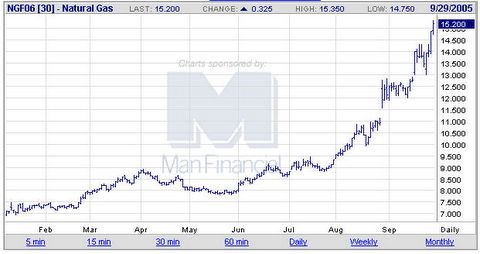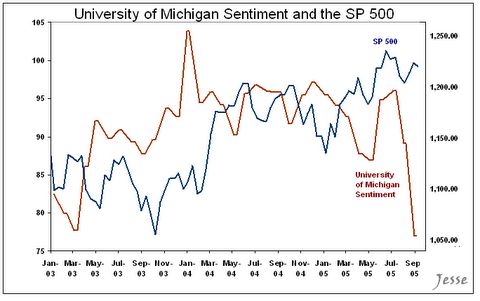Rita
Mish Moved to MishTalk.Com Click to Visit.
When hurricane Rita hit the Texas coastline at Beaumont/Port Arthur, as a category 3 hurricane, everyone breathed a sigh of relief. In terms of lives lost it certainly would be hard to fare better than we did. However, the Pollyanna viewpoint that there was minimal damage is just plain wrong. At sea Rita blasted her way through the Gulf of Mexico offshore oilfields as a Category 5 tempest doing mammoth damage to numerous rigs that will affect oil and natural gas production for quite some time. In addition some costal refineries were heavily damaged and that comes on top of refineries already crippled by Katrina.
Here are before and after pictures of Chevron's Typhoon platform in the Gulf platform with thanks to Resource Investor.
According to the department of energy, damage to some of the refineries in the Port Arthur TX and Lake Charles LA, and the lack of electrical power supply to others, is preventing their immediate return to service. Combined with the 5 percent of refinery capacity near the New Orleans area that was still out following Hurricane Katrina, as much as 15 percent of U.S. refinery capacity could be out for at least another couple of weeks.
As of Wednesday, September 28th, there are 4 refineries still shut down in the New Orleans area following Hurricane Katrina, 7 shut down in the Port Arthur and Lake Charles areas, and 3 shut down or attempting to restart in the Houston/Texas City/Galveston refining area, amounting to a total of over 3.5 million barrels per day that is currently offline. This accounts for over 1.5 million barrels per day of gasoline, over 800,000 barrels per day of distillate fuel, and over 400,000 barrels per day of jet fuel that is not being produced as long as these refineries remain shutdown.
A daily status report of Hurricane Impacts on the U.S. Oil and Natural Gas Markets can be found here .
The following highlights are from a DOE PDF as of September 28, 2005 (3:00 PM EDT).
- 945,506 customers are without electric power in Texas, Louisiana, Arkansas, and Mississippi. This includes new customer outages due to Hurricane Rita as well as outages remaining from Hurricane Katrina.
- As a result of damage from Hurricane Katrina and precautionary actions in advance of Hurricane Rita, shut-in oil production in the Gulf is currently at 1,511,715 barrels of oil per day. Shut-in gas production is at 8.027 billion cubic feet per day.
- The shut-in gas production is equivalent to 80.27 percent of the normal daily gas production in the Gulf, approximately 10 billion cubic feet per day.
- Evacuations are equivalent to 72.40 percent of 819 manned platforms and 47.76 percent of 134 rigs currently operating in the Gulf.
- There are reports that as many as 18 GOM rigs and 40 platforms may be missing, damaged and/or detached from their moorings.
Citgo, Lake Charles (324,300): three weeks
Total, Port Arthur (233,500): a month
Valero, Port Arthur (255,000): 2-4 weeks
COP, Westlake, (239,400): 2 weeks
Motiva, Pt. Arthur (285,000), wind damage, no power, no date given
Exxons's Beaumont plant (348,500) appeared to have no significant damage, and was awaiting power.
GOM shut-ins account for about 28% of total US oil output and 14% of total US natural gas output.
The Houston Chronicle is reporting a close call on natural gas for winter.
Winter is coming, and most of the natural gas wells in the Gulf of Mexico remain shut in. Industry officials say gas supplies will be adequate to heat Americans' homes through the colder months. But at what cost?Following is a chart of natural gas prices for the January 2006 Contract, as of September 29th.
"Based on everything we see right now, coming off of Katrina and Rita, we should be fine this winter," Natural Gas Supply Association Chairman Joseph Blount said Tuesday.
Consumers, however, won't be happy.
Even before Rita pushed natural gas prices to new highs, Guy Caruso, head of the Energy Information Administration, was estimating home heating bills this winter could jump as much as 70 percent in some parts of the Midwest.
Lawmakers on Capitol Hill are hurriedly responding to the latest energy crunch sparked by the hurricane duo by writing a new energy bill. House Energy and Commerce Committee Chairman Joe Barton, R-Ennis, today will push a provision to encourage construction of a natural gas pipeline across Alaska and bring new supplies to the lower 48 states. Resources Committee Chairman Richard Pombo, R-Calif., will sponsor a measure that would allow states to authorize oil and natural gas drilling off their coasts. Neither provision will help consumers this winter.
To date, hurricanes Katrina and Rita have deprived the markets of nearly 5 percent of the annual gas production that would have otherwise come from the Gulf.
Although natural gas is used year-round to generate electricity, demand is greatest in the winter months. To meet that seasonal demand, the industry must build inventories before the severe cold hits.
As of Sept. 16, 2.8 trillion cubic feet of gas was in storage, the Energy Information Administration reported. That's up about 3 percent from the five-year average, although down about 3 percent from the same time last year.
Industrial customers with the ability to switch from use of natural gas to heating oil have largely done so. Residential customers typically don't have the luxury of switching. Their demand depends on the weather.
Forecasters are predicting a warmer-than-normal winter, although cooler than last year. Overall, the natural gas association estimates residential gas demand will be up more than 7 percent from last year.

To see a more current chart click here.
On Wednesday we looked at rising Credit Card Delinquencies. Here is a small snip:
The American Bankers Association reported Wednesday that the percentage of credit card accounts 30 or more days past due climbed to an all-time high of 4.81 percent in the April-to-June period. It could grow in the months ahead, experts said.
Those figures were pre-Katrina and pre-Rita. Not only do we have continued high prices for gasoline, we have record high prices for natural gas as well. If the experts are correct and Midwest heating bills rise 70% this winter, there is sure going to be a lot more economic stress than we see right now.
Consumer sentiment is already falling thru the floor and that is before any of those heating bills have hit. Here is a chart of consumer sentiment to ponder, with thanks to Jesse.

Mish, is this a weather related outlier or are consumers finally ready to toss in the towel? Good question but I think that sticky gas prices, rising interest rates (eleven consecutive rate hikes and more threatened), falling real wages, two hurricanes with possibly more to come, rising foreclosures, rising delinquencies, and looking ahead to even 30% hikes in winter heating bills let alone the 70% that is projected is likely to be the brick that broke the consumers' back. The recession of 2006 is coming up.
Mike Shedlock / Mish
http://globaleconomicanalysis.blogspot.com/

